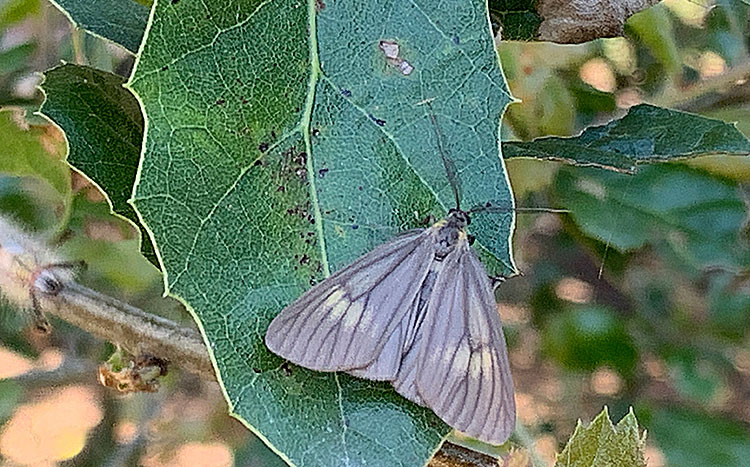By Don Cox, Master Arborist

The eggs that were laid on the underside of oak leaves will hatch in early July as tiny caterpillars. Affectionately known as “oak worms,” this is the larval stage in the oak moth life cycle. Oak worms begin feeding on the oak leaves, growing in size and appetite until August and September when they become the feared local force-of-nature that defoliates oak trees and creates a giant mess and nuisance for residents.
Oak Moth Eggs: Late June
It doesn’t happen in a big way every year, but when it does, there are two complete life cycles, the overwintering spring feeding generation, and the summer-fall generation. This year the spring generation was starting to build up, so the summer generation may be significant.
Newly Hatched Oak Moth Caterpillars: Early July
There have been a lot of moths flying, we think there’s going to be a big outbreak in the county this summer” says Geno Vitale of Vitale Tree Care in Santa Cruz. Geno is a local arborist, plant health care specialist, and IPM (Integrated Pest Management) provider.
The oak moth caterpillar is not a killer of otherwise healthy trees, in fact it’s not all bad. The native insect is part of oak woodland ecology and when active, is food for birds, lizards, spiders, and wasps. As they feed, the droppings become fertilizer like worm castings, concentrated nutrient replenishment for the oaks.
For trees in the undisturbed natural woodland there is no need to control the oak worm activity. Trees defoliated in summer and fall will re-foliate by next spring. But for oaks that are stressed due to poor growing conditions, development impacts, or are an important aesthetic and shade feature of a home or business environment, owners and managers may choose to control the insect before defoliation begins.
And then there is the nuisance, the mass descent and movement of mature caterpillars when they seek habitat for the pupal (chrysalis) stage can be overwhelming.
Most pest control operators use harsh chemical insecticides, pyrethroids, neonicotinoids, carbamates, or organo-phosphates. Stem injection with a systemic chemical insecticide is a closed system method of control without spraying. This involves drilling into the tree trunk and injecting the material directly into the conductive vessels of the tree.
This method is best utilized in spring when soil moisture and active tree metabolism facilitates the translocation of the material; uptake and effectiveness is not always dependable in the summer. Low soil moisture and slowed metabolism of oaks does not favor consistent results with stem injection during the summer.
Mature Oak Worm Feeding on Oak Leaves: August – September
Many residents wait to call for treatment until the oak worms are noticeable, when they are maturing and feeding heavily, defoliating the trees and starting to descend and become a nuisance. By then its too late for the organic, preventive approach and harder chemistry will be needed for knockdown.
The time to call for assessment and quotes for treatment is in early July when applications can be scheduled to proactively avoid the defoliation and nuisance.
•••
For more info, contact Don Cox, Master Arborist, at drtreelove@gmail.com or visit www.FertileEarthLandCare.com (Affiliated with Vitale Tree Care)